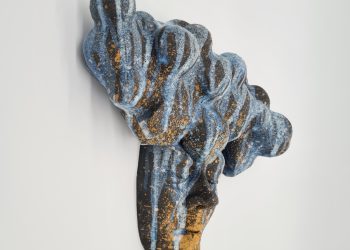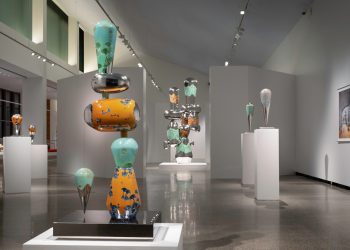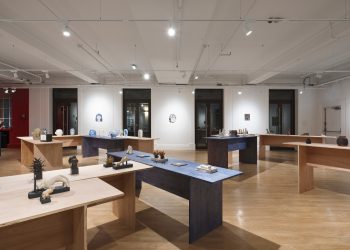
From functional, to decorative or aesthetical, your works also vary in techniques and materials. Tell us about your woolen felt creations.
I am drawn to the painterly and sculptural characteristics of felt making with its broad capabilities as a “hard textile” but which also lends itself to soft, sensual body wraps. I like the challenge of completing a work that functions in a practical way as well as becoming an object of aesthetic value. Unlike weaving, each felt piece is disconnected from the next, so in that way, a seamless, three-dimensional vessel, hat or bag may remind us more of a ceramic form than a textile.
The essential material of wool comes from sheep that grow new fleeces each year and which have served mankind in very isolated regions of the world. I love the natural color of wool, as well as, the possibility to blend it with other fibers, to dye the wool or to over dye a completed piece and manipulate its’ shape through this procedure. Now with years of practice I can approach a work from different angles, theorizing that method works best for expected results, but while shaping and finishing I am on the alert to pick up on a characteristic born through the process that I never figured on. This spontaneity keeps things very interesting.
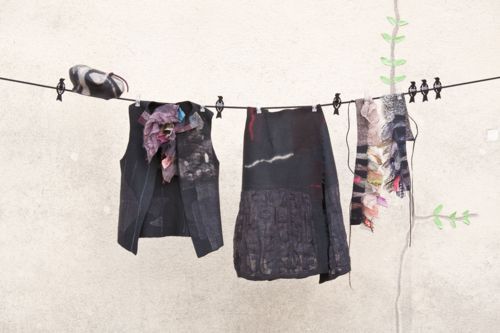
Jorie Johnson Spring Collection 2011 (beret, vest, skirt, neck wraps), wool, novelty yarn, silk fabric, linen lace fabric, silk cord. Photo by Toyoda Yuzo – View her works
You are using many layering techniques. Can you explain the process of making a new piece? How long does it take?
The matrix of the work is hard to see by the naked eye but while the selected wool fibers start their migration progress they entangle and actually pierce and consume auxiliary materials such as Japanese Washi, silk organza, cotton gauze, skeletal leaves, lace and so on, into the surface of the fabric and become an integral part of the finished fabric we call as FELT. Under optimal conditions (increase in humidity, higher temperatures, change in pH, application of agitation, etc.) and using a selection of different sheep breeds a variety of fabrics result from dense, coarse carpet weight to silky merino blends for sensual neck wraps.
In order to achieve fine fabrics, I use many thin layers of carded wool but for the loftier carpets I use coarser wool in thicker layers. Once the design and materials are selected and the shrink factor determined I work as swiftly as possible to complete a piece within a few days as not to cause the wet wool and auxiliary materials to begin to break down. I have to commit to “work swipe” as I call it, not to damage the wool, silk or other materials by keeping them wet for too long.
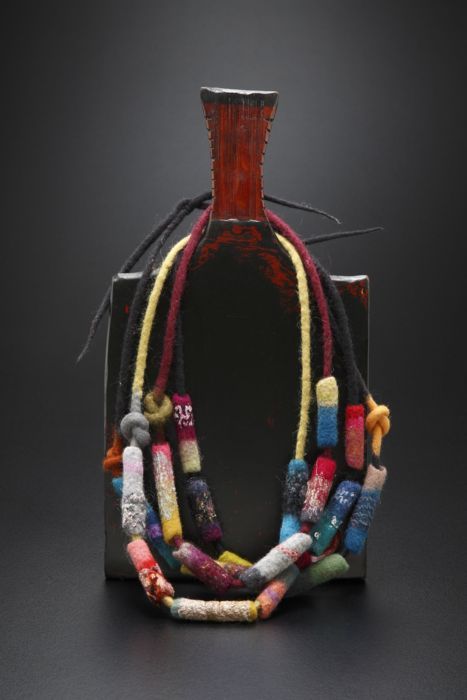
Log Bead Necklaces 2009, metallic and silk fabric, novelty yarns, wool. Photo by Toyoda Yuzo
Designed to coordinate with woolen garments and to have a the look of ceramic or glass but be a lighter weight body adornment. – View her works
Where do you get your inspiration from and what motivates you?
Living in Japan I do not lack for a variety of ceramic surfaces to study and translate into felt. I look for combinations of materials, colors, and textures that strike conversations with each other. Color application in paintings, lighting in landscapes and searching for new expression in such an old textile technique, demands much time with simple experimentation for specific surface outcomes. I enjoy just as much the rough effect of a Central Asian nomadic felt coat as I do the juxtaposition and over-lapping of Italian designer fashion fabrics as well as striking Scandinavian interior goods.
Finland was the first place I learned how to manipulate carded wool into a pair of extremely warm hand felted boots. Growing up in Boston, my father had a wool and fiber brokerage firm, so I have seen New England industrial felt and boiled wool samples since childhood.
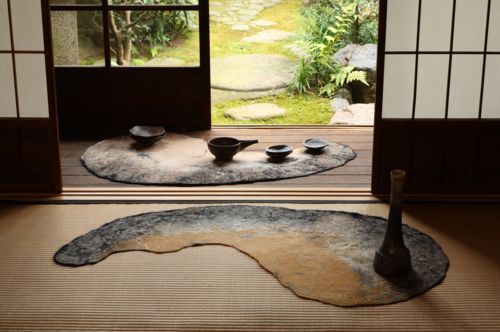
Gourd Runner I table center/tatami series, natural color and vegetable-dyed wool, flax, kudzu fiber, skeletal leaves. Photo by Toyoda Yuzo – View her works
– Surrounded by lots of lovely Japanese ceramics I wanted a new way to initiate conversations between the clay objects, textiles, and the room interior. In order to protect the table top, tray surfaces or tatami from rough ceramic bottoms I designed a group of felt textiles to solve the problem. Also, the clay, grass fibers, trees, and sheep all exist in the same environment, so I found that the combination of materials was very simpatico and coordinated naturally together in almost any interior setting. Nice with clay pots, glass vessels, and wood.

Sumi Silk Vest & Jacket 2009, wool, Sumi ink on silk fabrics. Photo by Toyoda Yuzo – View her works
The Sumi ink painting on silk was a collaboration with Christine Flint Sato (Nara, Japan/UK)
Through your works (and research), you are examining the significance of textiles as a major living expression. What can you tell us about this movement? Where do you see contemporary textile art in 10-20 years?
Probably more than any other art form, “Textile Art” has expanded its’ borders and become more versatile, including a broader range of descriptions, and now it may include paper, felt, dried fruit skins, metal and so on, rather than being marginalized as only weaving or dyeing as it was in the past. I believe it can only garner further interest through research in textile structures, methods, materials and imagery and will be sought after by artists of other mediums. Maybe the “textile” prefix will be dropped in the future.
Are you planning new exhibitions or workshops? Where can we find you and your works in the next future?
-CANADA: 2011 Oct 14 – Nov 11 Jorie Johnson Warm Biz Collection at The Silk Weaving Studio, Granville Island, Vancouver, BC, Tel: 604- 687-7455 www.silkweavingstudio.com/
-HONG KONG: 2011 Dec 14 – Jan 4 Animal Fiber: Art Informs Shibori, Hong Kong Design Institute’s HKDI Gallery (can’t find the address now) in conjunction with the 8th International Shibori Symposium 8iss.wordpress.com
-JAPAN: 2012 Jan 14 – 22: Jorie Johnson Warm Biz Collection, Ecru + HM, Okuno Building 4Fl, Ginza, Chuo-ku, Tokyo, Tel: 03-3561-8121 www.ecruplushm.com/index.html
-USA: 2012 Apr 24 – Jun 2: TEXTILES TODAY/Redefining the Medium, Durango Arts Center, 802 East Second Ave., Durango, CO Tel: 970-259-2606
Workshops: Find news about my summer 2012 workshops in Switzerland, Germany, Canada and the USA on my website http://www.joirae.com/
Jorie Johnson enjoys designing, producing and wearing her unique handmade woolen felt creations. Introduced to the traditional textile technique in Finland, in 1977, by learning to make Scandinavian felt boots, Jorie was immediately enchanted by the magic and power of felting.
Jorie grew up in the household of a wool and fiber merchant and studied textile design for industry at RISD (USA) and KOTO (Finland). While on a whimsical 3-month tour of Japan in 1987, she decided that twelve weeks simply was not long enough, and she’s lived there ever since. It was in Kyoto, Japan, that she re-established her textile studio and trademarked the name Joi Rae.
After studying industrial textile design (weaving and printing) for fashion and interiors Jorie found her compatible expression in fiber through the traditional medium of feltmaking. Her combination of rich colors and layering techniques, working various materials such as silk, rayon, and mohair into the felt product, results in warm, one-of-a-kind autumn, winter and spring clothing and accessories for the discerning collector.
By Vasi Hirdo.
Published in Ceramics Now Magazine Issue 1.
Visit Jorie Johnson’s website.
















